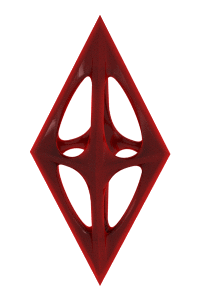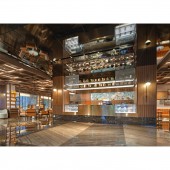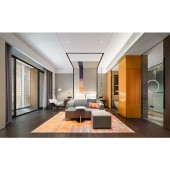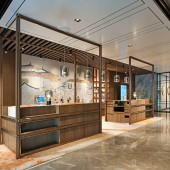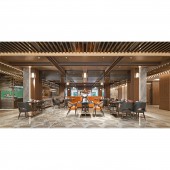Xian Canopy Hotel by Jingwen Chen |
Home > Winners > #148174 |
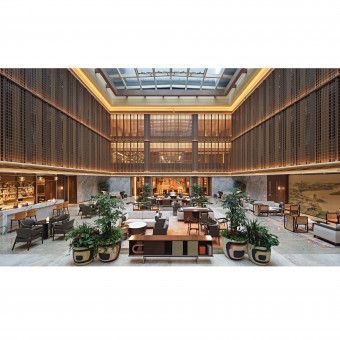 |
|
||||
| DESIGN DETAILS | |||||
| DESIGN NAME: Xian Canopy PRIMARY FUNCTION: Hotel INSPIRATION: Situated on a historic street in Xian, China, the hotel is surrounded by Tang Dynasty-style architecture and bustling cultural performances. Drawing inspiration from this vibrant historical context, the vision for the hotel's interior design aimed to create an immersive experience for guests, transporting them into the rich tapestry of local history. The ultimate goal was to deepen guests' travel memories and foster a genuine appreciation for the region's cultural heritage. UNIQUE PROPERTIES / PROJECT DESCRIPTION: This hotel's distinctive design approach seamlessly blends the essence of Tang Dynasty culture with contemporary lifestyle preferences, striking a balance between historical authenticity and modern sensibilities. The carefully curated spaces pay homage to the region's past while simultaneously embracing the expectations of today's discerning travelers. As a result, the hotel offers guests a unique and memorable stay, where the vivid echoes of the Tang Dynasty culture come to life, enriching their overall travel experience. OPERATION / FLOW / INTERACTION: The hotel is surrounded by Tang Dynasty historic sites and the target market are the young culture enthusiasts according to the Canopy branding. Therefore, we are focusing on finding a way to gather popularity and provide an atmosphere for the guest to immerse themselves in the neighbourhood culture. In order to achieve it, we focus on improving efficiency of the circulation by creating a Canopy Center which is like a hub, it is located at the atrium of the hotel, links all the main functions, such as check-in, lounge, lift lobby, restaurants, coffee shop, and multi-functional conference room which navigate the guest to go place to place smoothly and gather people to the Canopy Center with diverse evens that are held by the hotel. We also fucus on making the ancient lifestyle resonate with modern life. through the investigation of local culture, we integrated the ancient Tang Dynasty customs, characters together with contemporary lifestyle. For example, people might be intrigued by Tang Dynasty women riding motorcycles or taking selfies or attracted by Tang Dynasty youths leading horses. The design of the guest room adheres to the appropriate design concept to make the design look simply and at the same time reflect some cultural characteristics. For example, the wall covering with gradient colors on the bedside of the guest room is inspired by the representative bright and gradient clothing fabrics of the Tang Dynasty, and the orange produced by the gradient of yellow and blue happens to be the theme color of the hotel. PROJECT DURATION AND LOCATION: The project started in February 2021 and finished in December 2022, Located at Xian China. |
PRODUCTION / REALIZATION TECHNOLOGY: The hotel atrium was designed using innovative spatial planning techniques and intelligent circulation patterns to create a dynamic hub for guests. By strategically positioning key facilities such as restaurants, elevator halls, bars, meeting rooms, and coffee shops around the atrium, a seamless flow of movement is facilitated, promoting natural congregation and interaction. Acoustic design principles were incorporated to create an immersive atmosphere that supports diverse activities, such as music performances and talk shows, catering to guests throughout the day. The resulting design transforms the atrium into a versatile "canopy center" that engages and connects guests, truly embodying the concept of "for everyone, anytime." SPECIFICATIONS / TECHNICAL PROPERTIES: Project Area: 32000 square meters,125 guestrooms, functions included: Canopy center, restaurant, coffee shop, meeting rooms, GYM. TAGS: Xian, China, Tang Dynasty-style, historic street, cultural performances, immersive experience, local history, cultural heritage, modern lifestyle, guest travel memories RESEARCH ABSTRACT: The design research for the Xian historical elements began with a comprehensive study of the Tang dynasty's fashions, entertainment, food, places, lifestyle, and architectural style to identify key icons for integration into the hotel's interior design. A mixed-methods approach was utilized, combining qualitative and quantitative data from historical documents, architectural studies, and cultural analyses to create a better understanding of the era. Following the research, the team meticulously incorporated these Xian historical elements into the hotel's renovation project, ensuring a cohesive and culturally significant design. The project's impact extended beyond the appreciation of appearance, as it effectively bridged past and present, fostering a deeper connection between the hotel guests and the region's rich heritage. The insights gained from this research and the subsequent design execution have contributed to both the field of interior design and society as a whole, by demonstrating the importance of historical context and cultural sensitivity in contemporary design practices. This approach not only elevates the guest experience but also preserves and celebrates the unique cultural identity of the region. CHALLENGE: One of the most significant challenges during this design project was adhering to the tight completion schedule of one year, including demolition. To overcome this obstacle, efficient project management strategies were employed, such as the critical path method (CPM) and resource leveling, to optimize the allocation of resources and streamline the project timeline. Frequent communication and collaboration among cross-functional teams were essential to swiftly address any unforeseen issues and maintain momentum throughout the project's lifecycle. Another challenge was the seamless integration of Xian's historical elements with a vibrant, modern lifestyle that would appeal to the target demographic of younger guests. To achieve this, the design team engaged in a meticulous research process, exploring various aspects of the Tang dynasty and identifying key components that could be adapted to contemporary aesthetics. Designer also drew inspiration from modern design trends, blending historical and contemporary elements to create a unique and engaging space that caters to both the appreciation of history and the desire for a lively, contemporary atmosphere. ADDED DATE: 2023-02-09 09:37:01 TEAM MEMBERS (1) : IMAGE CREDITS: Image #1: Photographer Zhang Da Qi, Jingwen Chen (Interior design, Senior designer), Canopy center, 2023 |
||||
| Visit the following page to learn more: https://www.hilton.com/en/hotels/xiypypy |
|||||
| AWARD DETAILS | |
 |
Xian Canopy Hotel by Jingwen Chen is Winner in Interior Space and Exhibition Design Category, 2022 - 2023.· Read the interview with designer Jingwen Chen for design Xian Canopy here.· Press Members: Login or Register to request an exclusive interview with Jingwen Chen. · Click here to register inorder to view the profile and other works by Jingwen Chen. |
| SOCIAL |
| + Add to Likes / Favorites | Send to My Email | Comment | Testimonials | View Press-Release | Press Kit |
Did you like Jingwen Chen's Interior Design?
You will most likely enjoy other award winning interior design as well.
Click here to view more Award Winning Interior Design.

